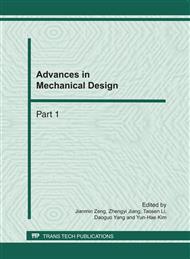p.500
p.505
p.509
p.513
p.518
p.522
p.526
p.530
p.534
Out-Plane Stability of Derrick of Inclined Drilling Rig
Abstract:
K-type derrick of inclined drilling rig that is top driving is usually loaded by axial compression, lateral force and concentrated torque simultaneously, and is more prone to out-plane instability due to its poor torsional rigidity. Here the upper segment of derrick was simplified as cantilever beam-column with laced-bar lattice structure. Stability model was established by energy method, and Ritz method was employed to obtain deformation curves for lateral deflection and torsion. Effects of dip angle of derrick and position of top drive on deformation were analyzed. At last the out-plane instability process of derrick is presented by increasing longitudinal compressive force gradually. For ultimate loads of well drilling condition, out-plane stability requirement of derrick is met.
Info:
Periodical:
Pages:
518-521
Citation:
Online since:
February 2011
Authors:
Keywords:
Price:
Сopyright:
© 2011 Trans Tech Publications Ltd. All Rights Reserved
Share:
Citation:


